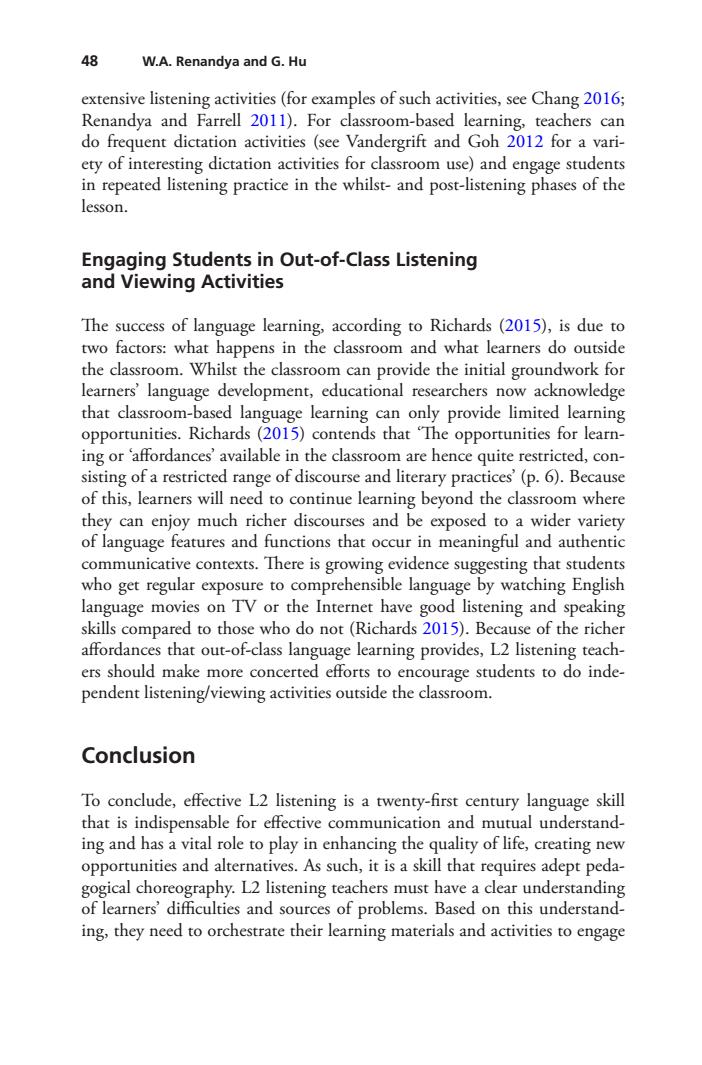正在加载图片...

8 W.A.Renandya and G.Hu extensive listening activities(for examples of such activities,see Chang 2016 Renandya and Farrell 2011).For classroom-based learning,teachers can do frequent dictation activities(see Vandergrift and Goh 2012 for a vari- ety of interesting dictation activities for classroom use)and engage students in repeated listening practice in the whilst-and post-listening phases of the lesson Engaging Students in Out-of-Class Listening and Viewing Activities The success of language learning,according to Richards(2015),is due to two factors:what happens in the classroom and what learners do outside the classroom.Whilst the classroom can provide the initial groundwork for learners language development,educational researchers now acknowledge that classroom-based language learning can only provide limited learning opporunities.Richards(2015)contends thatThe opportunities for leam- ing or 'affordances'available in the classroom are hence quite restricted,con- sisting of a restricted range of discourse and literary practices'(p.6).Because of this,learners will need to continue learning beyond the classroom where they can enjoy much richer discourses and be exposed to a wider variety of language features and functions that occur in meaningful and authentic communicative contexts.There is growing evidence suggesting that students who get regular exposure to comprehensible language by watching English language movies on TVor the Interet have good listening and speaking skills compared to those who do not(Richards 2015).Because of the richer affordances that out-of-class language learning provides,L2 listening teach- ers should make more concerted efforts to encourage students to do inde pendent listening/viewing activities outside the classroom. Conclusion To conclude,effective L2 listening is a twenty-first century language skill that is indispensable for effective communication and mutual understand- ing and has a vital role to play in enhancing the quality of life,creating new opportunities and alternatives.As such,it is a skill that requires adept peda- phy.L2 listening teachers must have a clear understandin oerifcutieand sourcs of problems.Basedothsde ing,they need to orchestrate their learning materials and activities to engage48 W.A. Renandya and G. Hu extensive listening activities (for examples of such activities, see Chang 2016; Renandya and Farrell 2011). For classroom-based learning, teachers can do frequent dictation activities (see Vandergrift and Goh 2012 for a variety of interesting dictation activities for classroom use) and engage students in repeated listening practice in the whilst- and post-listening phases of the lesson. Engaging Students in Out-of-Class Listening and Viewing Activities Te success of language learning, according to Richards (2015), is due to two factors: what happens in the classroom and what learners do outside the classroom. Whilst the classroom can provide the initial groundwork for learners’ language development, educational researchers now acknowledge that classroom-based language learning can only provide limited learning opportunities. Richards (2015) contends that ‘Te opportunities for learning or ‘afordances’ available in the classroom are hence quite restricted, consisting of a restricted range of discourse and literary practices’ (p. 6). Because of this, learners will need to continue learning beyond the classroom where they can enjoy much richer discourses and be exposed to a wider variety of language features and functions that occur in meaningful and authentic communicative contexts. Tere is growing evidence suggesting that students who get regular exposure to comprehensible language by watching English language movies on TV or the Internet have good listening and speaking skills compared to those who do not (Richards 2015). Because of the richer afordances that out-of-class language learning provides, L2 listening teachers should make more concerted eforts to encourage students to do independent listening/viewing activities outside the classroom. Conclusion To conclude, efective L2 listening is a twenty-frst century language skill that is indispensable for efective communication and mutual understanding and has a vital role to play in enhancing the quality of life, creating new opportunities and alternatives. As such, it is a skill that requires adept pedagogical choreography. L2 listening teachers must have a clear understanding of learners’ difculties and sources of problems. Based on this understanding, they need to orchestrate their learning materials and activities to engage